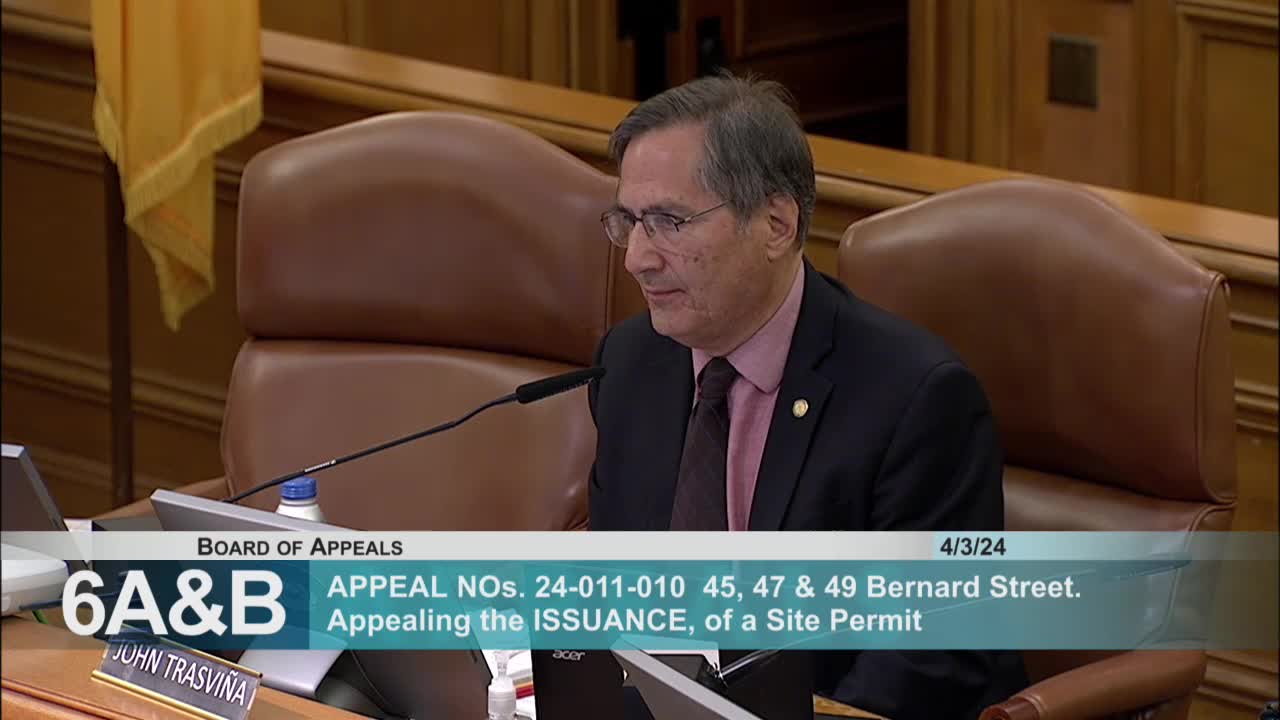San Francisco Board of Appeals reviews controversial housing project and compliance issues
April 03, 2024 | San Francisco City, San Francisco County, California

This article was created by AI summarizing key points discussed. AI makes mistakes, so for full details and context, please refer to the video of the full meeting. Please report any errors so we can fix them. Report an error »

In the heart of San Francisco's bustling city hall, a recent government meeting unfolded, addressing critical issues surrounding a proposed residential project that has sparked community debate. The discussions centered on the adequacy of open space for new housing units, a topic that resonates deeply in a city grappling with housing shortages and urban density.
As the meeting progressed, city officials examined the planning code requirements for open space, revealing that the current design of the property in question falls short. The second and third-floor units lack compliant open space, with only one lower unit having access to a small private area. This deficiency has raised questions about the project's overall viability and its alignment with city regulations. While the planning code mandates a minimum of 100 square feet of open space, the existing setup does not meet this standard, leaving the upper units in a legally deficient position.
Kevin Birmingham from the building department emphasized that the current permit focuses on essential structural upgrades, specifically the replacement of a century-old brick foundation. He assured that any future additions, such as a roof deck or accessory dwelling unit (ADU), would be scrutinized to ensure compliance with safety and building codes. The conversation shifted to fire safety measures, with officials discussing the merits of installing fire escapes versus sprinklers, highlighting the complexities of modernizing older buildings.
Public comments added another layer to the discussion, with land use attorney Sarah Hoffman voicing support for the project. She argued that the planning commission's decision to remove the roof deck and reduce the project's scope was not justified and that the project aligns with the neighborhood's character. Hoffman pointed out that many homes in the area feature roof decks, and the proposed design would not only enhance living conditions but also contribute to the community's overall aesthetic.
As the meeting concluded, it became clear that the path forward for this project remains uncertain. The balance between adhering to planning codes and addressing community needs continues to challenge city officials and residents alike. With housing demands on the rise, the outcome of this discussion could set a precedent for future developments in San Francisco, underscoring the ongoing struggle to create livable spaces in an ever-evolving urban landscape.
As the meeting progressed, city officials examined the planning code requirements for open space, revealing that the current design of the property in question falls short. The second and third-floor units lack compliant open space, with only one lower unit having access to a small private area. This deficiency has raised questions about the project's overall viability and its alignment with city regulations. While the planning code mandates a minimum of 100 square feet of open space, the existing setup does not meet this standard, leaving the upper units in a legally deficient position.
Kevin Birmingham from the building department emphasized that the current permit focuses on essential structural upgrades, specifically the replacement of a century-old brick foundation. He assured that any future additions, such as a roof deck or accessory dwelling unit (ADU), would be scrutinized to ensure compliance with safety and building codes. The conversation shifted to fire safety measures, with officials discussing the merits of installing fire escapes versus sprinklers, highlighting the complexities of modernizing older buildings.
Public comments added another layer to the discussion, with land use attorney Sarah Hoffman voicing support for the project. She argued that the planning commission's decision to remove the roof deck and reduce the project's scope was not justified and that the project aligns with the neighborhood's character. Hoffman pointed out that many homes in the area feature roof decks, and the proposed design would not only enhance living conditions but also contribute to the community's overall aesthetic.
As the meeting concluded, it became clear that the path forward for this project remains uncertain. The balance between adhering to planning codes and addressing community needs continues to challenge city officials and residents alike. With housing demands on the rise, the outcome of this discussion could set a precedent for future developments in San Francisco, underscoring the ongoing struggle to create livable spaces in an ever-evolving urban landscape.
View full meeting
This article is based on a recent meeting—watch the full video and explore the complete transcript for deeper insights into the discussion.
View full meeting
